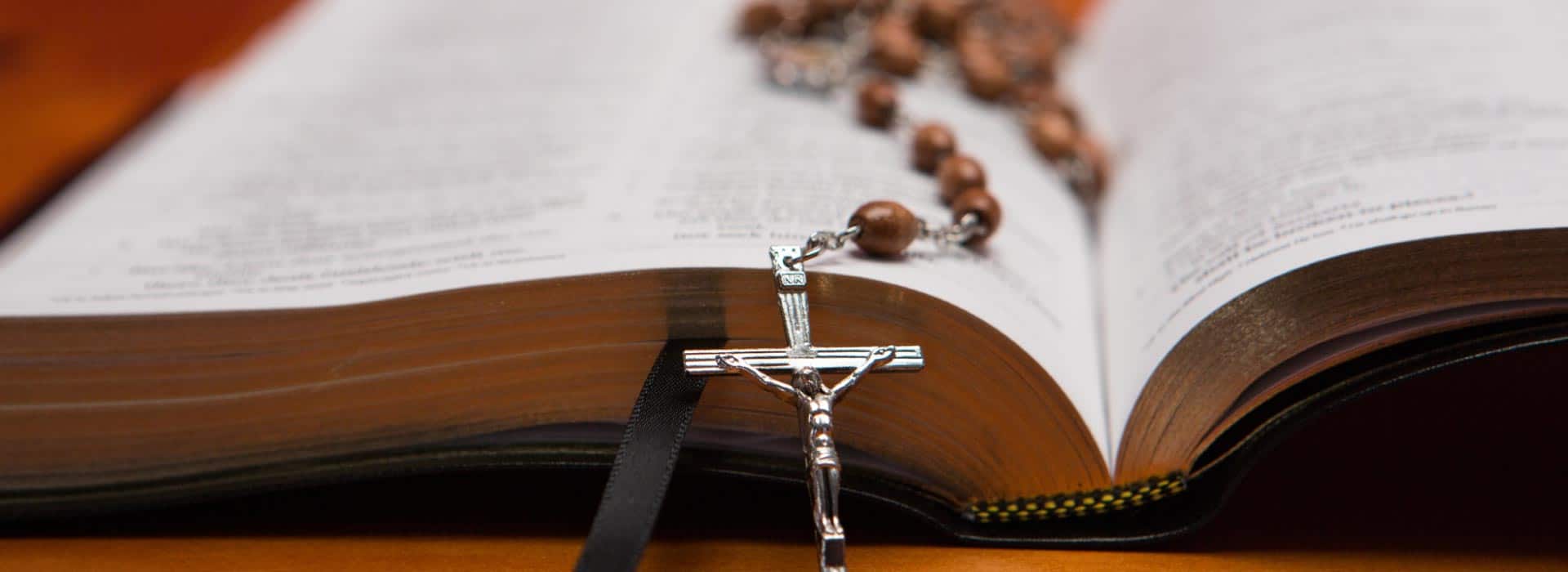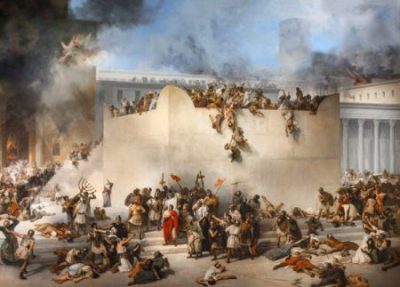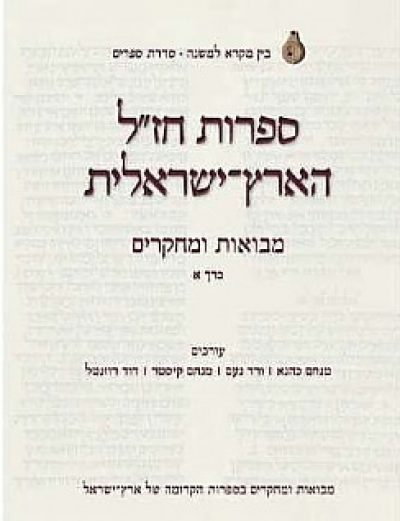While often mis-translated as “law” Torah means “teaching.” Torah is used in the widest possible sense including teaching, wisdom, doctrine, heritage and tradition and can refer to specific books or to the entire scope of Jewish learning. Jewish tradition speaks of two “Torahs” the oral and the written. When used alone, the word “Torah” usually refers to the written Torah. Jewish tradition sees Torah as a fundamental concept without which the world cannot exist. The public reading of the Torah is a major Jewish ritual and the commandment to study Torah (meaning all Jewish learning) is a mitzvah (s.v.) is seen as being equivalent to all the other commandments together.
Torah – Written
The written Torah, known as Torat Moshe (the Torah of Moses), is comprised of the “five books of Moses:” Genesis, Exodus, Leviticus, Numbers and Deuteronomy. According to traditional belief, God gave the (written) Torah to the tribes of Israel following their exodus from Egypt. The climax of this revelation was the revelation of the Ten Commandments at Mt. Sinai. The Torah includes the story of the family of Abraham and his descendants, their enslavement in Egypt and their redemption and their sojourn in Sinai en route to the promised land of Israel. Alongside this narrative—which includes many moral lessons—are many civil and ritual laws.
Contents and Canon: The Tanakh
The Torah is only part of the Tanakh or Jewish Bible. Tanakh is divided into three sections: Torah (the five books), Nevi’im (eight Prophetic books) and Ketuvim (Writings 11). These 24 books (as Jewish tradition counts them) are all included in the Christian scriptures but are counted differently (e.g. I Kings and II Kings are considered one book) and are sequenced in a slightly different manner (e.g. Ruth comes after Judges). Jewish tradition teaches that the Prophets were the authors of their own books as well as some of the others (Jeremiah wrote Lamentations). Psalms, Song of Songs, Proverbs and Ecclesiastes are attributed to Kings David and Solomon. The Tanakh was canonized by the rabbis (s.v.) in the second century. Nearly all of the Tanakh is in Hebrew, but some of the Ketuvim (e.g. Daniel) are in Aramaic.
Today many Jews accept the findings of modern scholarship and textual criticism according to which the Torah and other books were compiled from different literary strands over several hundred years both before and after the Babylonian exile (in the 6th century B.C.E.).
In Ritual use: Read in Synagogue

The Torah is also known as miqra – that which is read. It is divided into 54 parashot or portions, each of which is read in Synagogue during one week. Each week is called by the name of the Torah portion that is read four times during the week: a few verses on Shabbat afternoon, Monday and Thursday mornings and the entire portion on Shabbat morning. On Shabbat seven people are called up for `aliyot (going up) and are honored with the opportunity to say a blessing before and after a segment of the Torah portion is read.
The Torah must be written by hand, on parchment, with no punctuation or vocalization by a specially trained scribe. Reading the Torah in synagogue is a special skill and requires careful preparation so that it can be chanted according to the musical tradition (which varies from community to community). The Torah portion is the theme of the week and usually sermons will center on the contents of the portion. The centrality of Torah is indicated by the practice of using the names of the portions as the names of the weeks of the year. Shorter sections of the Torah are read on Rosh Hodesh (the new moon) and all festivals and fasts. Short selections from the Prophetic books, known as the haftara, are read after the Torah portion. Other short books are read in their entirety on certain holidays (e.g. Song of Songs on Passover).
In addition to the lectionary cycle, many sections of the Tanakh – especially from the Torah and the Psalms – are used in Jewish liturgy.
The Torah is also known as the Humash because it is comprised of five books. Today the word Humash usually refers to a book of Torah printed together with all the other readings from the lectionary for synagogue use. Even printed versions of the bible (which include vowels, punctuation and musical notation) are treated carefully but a genuine Torah scroll is handled with the utmost reverence. When it is taken out of the ark in the synagogue the entire congregation rises. Ashkenazi Jews dress the Torah in a cloth mantle while Sephardic and Oriental Jews keep it in a wooden case that is often covered with silver. The Torah is decorated with many ornaments one of which is often a crown symbolizing Jewish obedience to God, the giver of Torah, known as he King of the king of kings.”
Two holidays have a special connection to the Torah: Shavuot (Pentacost) is celebrated as the anniversary of God’s giving the Torah at Mt. Sinai. The receiving of the Torah is celebrated by all-night study in an attempt to recreate the power of the revelation. On Simhat Torah (“Festival of the Torah” which is the day after the seven days of Sukkot, Tabernacles) the annual cycle of reading the Torah is completed at the end of Deuteronomy and the reading begins again with the first chapter of Genesis. On this day the Torah is celebrated with great joy, which includes singing, dancing and drinking.
Commentary and Study
Study of Torah is a central Jewish value and Jewish bible study has focused on the Torah rather than on the Prophets or Writings. A traditional name for a Jewish primary school is Talmud Torah which means [place of] Torah study.
The Talmud says “read the Torah portion twice in the [Hebrew] original and once in [Aramaic] translation” which means that each week’s Torah portion should be studied thoroughly, preferably in the original Hebrew text. Generations of Jewish scholars have studied the text and recorded their commentaries. The greatest of these was Rashi who lived in France from 1040-1105.
Study bibles (“mikraot gedolot”) are printed with the Torah text in the center, flanked by the ancient Aramaic Targum or translation. Around the Torah text are classical commentaries by different Rabbis from different times and places. Each of these commentaries seeks to explicate the Torah and often they contradict one another and disagree. The page is a virtual conversation between bible scholars. Except for practical legal applications, Judaism does not hold that there is only one meaning of Torah. Rather, Torah is seen as having 70 facets like a valuable diamond. The layers of meaning that a student of Torah can learn are schematically described as:
Peshat – (simple) the literal meaning of the text
Derash – (interpretation) the homiletical meaning
Remez – (hint) the allegorical meaning
Sod – (secret) the esoteric meaning
The initials of these four layers of meaning spell PaRDeS meaning orchard (and which is derived from the same word as paradise) and is understood as suggesting that those who toil in the garden of Torah will harvest great benefit.
Torah – Oral
According to tradition, when Moses was given the Ten Commandments and the written Torah at Mt. Sinai he was also given an oral Torah which was passed on from generation to generation:
Moses received Torah from Sinai and handed it down to Joshua, and Joshua to the elders, and the elders to the prophets, and the prophets handed it down to the men of the Great Assembly. They said … make a fence round the Torah. (Mishna Avot 1:1)
Whether actually given at Sinai or not, the oral traditions were passed on and developed over hundreds of years. The transmitters of the oral materials are known as tannaim, which is Aramaic for “repeaters” as it was their job to be human recordings of the tradition. Much of the material is organized according to mnemonic schemes that facilitated its memorization. Little is known—and much is in dispute—about the earliest origins of the oral traditions and their transmission until the late years of the second Temple period. The tannaim became prominent in the last century of the Temple’s existence and many of them are known by name together with the traditions that they passed on.
Tanaitic Literature: Mishna and Midrash
After the Roman suppression of the Bar-Kokhba revolt, Jews were banished from Jerusalem and Judea. Jewish life was re-established in the Galilee in centers including Usha, Shefar`am, Tsippori and Tiberias. At Tsippori in the 3rd century the Jewish Patriarch Rabbi Yehuda Hanasi finalized the editing of the oral law and promulgated the Mishna. Mishna, which comes from the Hebrew word shana (like the Aramaic tana), means to learn by [oral] repetition. The Mishna may at this stage have still been an oral ‘document’ but it was written down and published shortly thereafter. At about this time other tannaitic traditions were compiled. These are the Tosefta and the tannaitic collections of Midrash.
Midrash, from the Hebrew darash, means to seek [meaning], and describes a literature which is scripture-dependant. The tannaitic Midrashim are collections of exegetical traditions that seek to connect the oral Torah and halakhic traditions to the biblical text. Because of the halakhic (legal) nature of these midrashim they exist only for the last four books of the Torah, as there is little legal material in Genesis.
While the tannaitic (sometimes called halakhic) midrashim follow the books of the Torah verse by verse, the Mishna and the Tosefta are organized thematically and stand independently of the written Torah. The Tosefta is comprised of other, often parallel, traditions not included in Rabbi Yehuda’s Mishna. Tannaitic literature is characterized by a terse style that has led to many commentaries, which sought to explain and elucidate these texts.
The Talmud
With its publication, the period of the tannaim came to an end. The Mishna was propagated amongst the scholars in the two major Jewish centers: the Land of Israel and Babylonia. These scholars are known as amoraim (Aramaic for “those who say”). From the third century the Mishna became the definitive Jewish legal text and consequently the subject of extended discussion. These discussions sought to understand the text more clearly, to apply the mishnaic law to specific cases and to reveal connections between the written and oral traditions (Torah and Mishna). The records of this study and discussion in the yeshivot (see below) of Israel and Babylonia are the Gemara, which is Aramaic for “learning.” The Mishna is predominantly written in Hebrew while the Gemara uses mostly Aramaic, together with much Hebrew.
Together the Mishna and the Gemara comprise the Talmud, which exists in two versions: the Babylonian (“Bavli”) with the gemara of Babylonian academies and the Talmud of the Land of Israel (known as the “Yerushalmi” or Jerusalem Talmud) which includes the gemara of the sages of the Galilee and Caesarea. The Mishna, and hence the Talmuds, is organized into six thematic “orders” (sedarim) which give a good overview of the realms of halakha:
1. Zera’im (agriculture and prayer)
2. Mo`ed (holidays and their rituals)
3. Nashim (personal—especially marital—status)
4. Nezikin (civil law and court proceedure)
5. Kodashim (the Temple, it’s sacrifices and laws of kashrut)
6. Toharot (ritual purity including ‘family purity’ [rules regarding sexual relations and menstuation])
In addition to halakhic (legal) materials, the Talmuds include a great deal of aggadic (homiletic) material in which one thing leads to another in an associative fashion. Other aggadic compositions of the amoraim were based on the Torah rather than on the Mishna. Some of these texts (also called midrashim) follow the bible verse-by-verse and offer exegetical insight on the biblical text, the historical narrative of the bible, ethical issues and much more.
Post-Talmudic Literature
The period of the amoraim came to an end in the 6th century after four centuries during which they generated a large literature of halakha and aggadah. In the following centuries Jewish learning was centered on the Talmuds and the writings of later sages (e.g. the geonim who were the heads of Babylonian yeshivot) who wrote comments on these texts. Other areas of study and literary creativity in the following millennia included: Jewish philosophy, Hebrew grammar, biblical commentary, the siddur or prayerbook and codes of halakhic rulings. Still more late midrashim were compiled. These are more lengthy sermon-like discourses which are less dependant upon a particular verse for their starting point; often their theme is a holiday. Among the great Rabbis whose names area associated with these endeavors are Rav Sa’adia Gaon of Egypt, Israel and Babylonia (882-942), Rabbi Yitzhaq Alfasi of Fes, Morrocco (1013 – 1103), Rambam or Maimonides of Spain and Egypt (1135 to 1204), Rashi of the Rhine valley in Franco-Germany (1040-1105), Ramban or Nachminides of Catalonia (1194-1270), and Rabbi Yosef Caro of Spain, Asia minor and Tsfat (1488 to 1575).
Torah Study: The Yeshiva
The world of these scholars was the yeshiva (literally sitting) or academy, where students sat at the feet of their teachers to learn Torah. The roots of the yeshiva or bet midrash (house of study) go back at least to the Talmudic period. (Paul was reputed to have studied at the feet of Rabban Gamliel.) Because of the centrality of Torah study tanaim and amoraim portrayed even the patriarchs as studying in yeshivot. A similar point is made by the Jewish practice to begin every day with the blessing: “Blessed are you, God, who teaches Torah to His people, Israel,” and by the image that reward in the world to come is Torah-study with none other than Moses “our Teacher” as instructor.
The Mishna itself includes a curriculum for Talmud Torah (learning of Torah in the broad sense):
Five years is the age for the study of Bible, ten for the study of Mishnah … fifteen-for the study of Talmud (Mishna Avot 5:21)
Other traditions state that one may study kabbalah (Jewish mysticism, s.v.) at the age of 40, after one has mastered the other Jewish disciplines. It may be said that Torah-study is a lifelong undertaking.
Today, yeshivot are the secondary and post-secondary schools in which higher Jewish learning takes place. Many religious male pupils study in high-school yeshivot (ישיבות תיכוניות) which are more rigorous in their curriculum than the non-yeshiva religious public schools. Young adult men continue their studies in “higher yeshivot” (ישיבות גבוהות) for men of army and university age. In the ultra-Orthodox world it is common for married men to continue their studies – sometimes for a lifetime. These yeshivot are called kolelim (singular: kolel).
In modern times the curriculum in yeshivot has focused almost exclusively on study of the Babylonian Talmud. Even Bible, as well as many other primary Jewish texts, is secondary—though Jewish moral texts are sometimes included. Some Israeli yeshivot with a modern outlook have given more emphasis to Bible and to the literature of the land of Israel (e.g. The “Jerusalem” Talmud and midrashim) than was previously customary.
One of the greatest changes in modern Jewish life is the development of Torah study opportunities for women. Until not long ago (and in ultra-Orthodox circles to this day) it was considered inappropriate for women to engage in serious Torah learning. (They were taught basic Bible and what was necessary to run a Jewish household.) In recent years many frameworks have been established for women’s advanced Torah study, including some on very high levels
Torah study is not restricted only to those who pursue it full-time. Most synagogues and many educational institutions offer regular classes and one-time lectures on a wide variety of Torah topics. The mishnaic dictum “do not say ‘I will study when I have time,’ for perhaps you will never have time [ואל תאמר לכשאפנה אשנה שמא לא תפנה] (Avot 2:4) is understood that all Jews should study some Torah every day. In fact, the daily prayerbook includes many passages from the oral and written Torah and the recitation of these passages is regarded as a type of Torah study.
Those preparing for ordination as a Rabbi (s.v.) will engage in rigorous study of the codes of Jewish law, most specifically the Shulhan `Arukh of Rabbi Yosef Caro and the commentaries upon it






